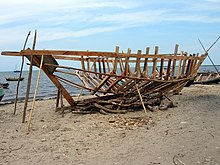Wooden boat
A wooden boat or wooden boat is a boat or ship , whose hull , hull and superstructure are made entirely of wood. In addition to wood, nails, screws and adhesives can also be used.
Forms of development of the wooden boat
The dugout canoe
The first aid for moving on a body of water was the dugout canoe , a complete tree trunk , around 8000 years ago . Archaeologists do not agree on the exact chronological order . The first trees were hollowed out by man thousands of years ago in order to make it possible to navigate bodies of water, first by burning out the tree trunk and later by machining processes .
It can be assumed that the path from the dugout canoe to the boat took place via the detour of the hide and basket boat, as man acquired the ability to weave willow and reed , tanning and sewing leather long before he was able to Obtaining planks and boards from trees. The existence of the pirogues also indicates that there was also a dugout canoe (with attached side paneling ) to increase the freeboard . Dugout canoes were made up to 20 meters long.
The canoe
It is easier and faster, the shape of the hollowed Einbaumes with willows , bones or reeds replicate and this frame with leather or skin to string. The stern and bow of this boat were given a more aerodynamic shape. Such a canoe could not be built arbitrarily large, as it threatens to break / tear during operation. Larger canoes had to be reinforced with more stable material such as planks and boards made of wood. With that the wooden canoe grew in size, seaworthiness and payload.
The classic boat shape
Boats that were supposed to be larger than a log or canoe had to be constructed in a fundamentally different way. For this reason, hull constructions composed of wooden frames and wooden planks developed in ancient times.
Two ways of traditionally producing such wooden hulls are known. Either the outer shell was first made from planks and then later stiffened with frames . Or the frame construction was first attached to a keel and this frame structure was then paneled. The second way allowed significantly larger and more stable constructions.
Material mixes
Composite construction made of iron frames and wooden planks
The next step, the composite construction method, allowed even larger ships, because the load capacity of wooden frames is limited. In composite construction, different materials are combined with one another. It became customary to make the frame of the ship, the frames and the keel out of iron and then to plank it with wood.
Sandwich construction with copper sheets
If several layers of solid different materials are connected to one another, this is known today as sandwich construction . It found its way into shipping with the help of the nail, when the underwater ships of the wooden hulls began to be protected with copper sheets to keep the wood worm away. Copper nails were preferred because iron corrodes quickly in contact with copper . A famous ship of this type was the " Cutty Sark ".
The end of wooden boat building
As early as the end of the 19th century, large ships were made entirely of iron or steel, a development that also influenced boat building.
At the beginning of the 1960s, the first ships were also made of plastic . Either the sandwich construction was used, in which the plastic was applied to both sides of boat building plywood, or in composite construction, in which the sandwich outer skin was attached to wooden frames. With the technical progress in plastics and the invention of composite plastics such as GRP , wood has been displaced as a material. Wood could only hold up in interior construction. And only in non-commercial shipping. From the mid-1990s, there were even plastics with a feel reminiscent of wood.
The rebirth of the wooden boats
A number of plastics proved to be not particularly durable and the increasing proportions of plastic made it increasingly difficult to repair the boats. In addition, the lifespan of plastic boats depends on factors that are beyond the control and verification of the buyer, which is why some boat owners are now again preferring wood as a material.
In addition, there was the ecological awareness of society, which from the mid-1980s at the latest saw wood as a renewable raw material, while most plastics are made from petroleum . New manufacturing methods have done the rest to make wooden boats more durable and robust. Since the late 1980s, wooden boats have therefore regained market share .
The development of the Stitch and Glue process (stapling and gluing together plywood parts) enables laypeople to realize individual wooden hull constructions without in-depth knowledge of boat building.
Whilst shipyards that specialized in the manufacture of wooden boats were almost extinct, there are hundreds of them again in Europe alone, and the trend is increasing.
The polar ship Arctic Janus is considered to be the largest operating wooden ship with the corresponding ice class worldwide.
Renaissance of classic yachts
In the 90s there was a growing interest in the maintenance of classic yachts and regattas with these elegant wooden boats. The regatta events Regates Royales in Cannes and the Nioulargue in St. Tropez became meeting points for owners and lovers of this increasingly rare evidence of the art of boat building. The tradition of wooden boats is cultivated in Germany, along with many class associations, by the Friends of Classic Yachts .
The beginning of the "Classic Yacht Age" was in the first half of the 20th century when the first yachts were built exclusively for racing purposes. The improvement in shapes, construction methods, and materials led to the construction of sophisticated racing yachts. A highlight for the pursuit of beauty, fitness and speed was the 1907 adopted by IYRC in London meters formula as that designers William Fife , Henry Rasmussen and Nathanael Herreshoff inspired aesthetic and craft excellence. "Wood is so wonderful, lively, aesthetic. It can be bent beautifully and evenly from point to point. It conducts neither temperature nor noise particularly well, which is why a wooden boat has a pleasant temperature inside and is relatively quiet." With this declaration of love, boatbuilding legend Olin Stephens , the creator of the classic sea bream , justifies his lifelong passion for the natural and fascinating material wood.
The end of the "classical" period - until its renaissance - began with the technological leap towards mass production of GRP boats in the 1960s.
The impact of wooden ship / boat building on the environment
Due to the high consumption of wood, depending on the region, wooden shipbuilding had e.g. T. a considerable influence on the forest cover or the lack of such. Already in antiquity certain areas were completely deforested and forests were pushed back due to the consumption of wood. Are known z. B. the ecological effects of the deforestation of large parts of North Africa , with the consequence of the spread of deserts . Shipbuilding experienced another high phase in the 17th and 18th centuries with the large fleets of European colonial powers . One example is the completely changed vegetation composition due to the deforestation of the laurel forests on Madeira Island . The precious laurel wood was mainly used for shipbuilding.
literature
- Thomas Larsson: Wooden Boats - Renovating and Maintaining . 2nd Edition. Delius Klasing, 2005, ISBN 978-3-7688-1677-9 .
- Adolf Brix: Boat building - practical shipbuilding . 7th edition. Delius Klasing, 1929, ISBN 978-3-89225-382-2 .
- Gilles Martin-Raget: Dream yachts - the classics . Heyne, ISBN 978-3-453-15955-6 .
- Duncan Haws: Ships and the Sea. Chronicle of the seafaring . Weltbild, ISBN 978-3-7688-1225-2 .
Web links
- Christian Jakob: craftsmanship! How to build a boat , SWR Fernsehen - Landesschau Rheinland-Pfalz from November 2, 2018 (YouTube from July 27, 2018)
Individual evidence
- ^ Arnold Kludas , Robert Scharff, Guido Canestari: Ships . In: A what-is-what book . tape 25 . TESSLOFF Verlag, 2002, ISBN 3-7886-0265-1 , p. 4–5 (48 p., Limited preview in Google Book search).
- ↑ Yacht Club de Cannes. Retrieved December 30, 2008 .
- ↑ Rank and name - a gigantic array of modern and classic dream yachts at the Nioulargue. September 30, 2006, accessed December 30, 2008 .
- ↑ http://www.fky.org/kontakt.htm


